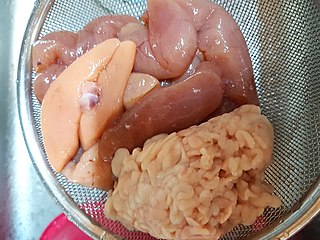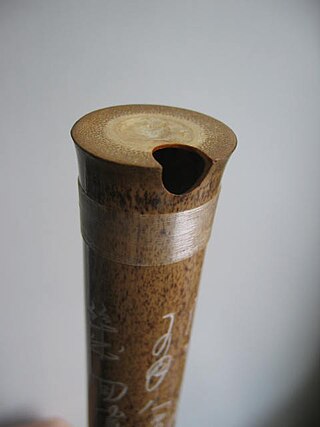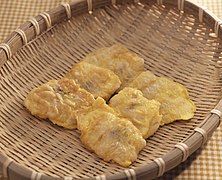
Reynoutria japonica, synonyms Fallopia japonica and Polygonum cuspidatum, is a species of herbaceous perennial plant in the knotweed and buckwheat family Polygonaceae. Common names include Japanese knotweed and Asian knotweed. It is native to East Asia in Japan, China and Korea. In North America and Europe, the species has successfully established itself in numerous habitats, and is classified as a pest and invasive species in several countries. The plant is popular with beekeepers, and its young stems are edible, making it an increasingly popular foraged vegetable with a flavour described as lemony rhubarb.

Bamboos are a diverse group of mostly evergreen perennial flowering plants making up the subfamily Bambusoideae of the grass family Poaceae. Giant bamboos are the largest members of the grass family, in the case of Dendrocalamus sinicus having individual stalks (culms) reaching a length of 46 meters (151 ft), up to 36 centimeters (14 in) in thickness and a weight of up to 450 kilograms (1,000 lb). The internodes of bamboos can also be of great length. Kinabaluchloa wrayi has internodes up to 2.5 meters (8 ft) in length. and Arthrostylidium schomburgkii has internodes up to 5 meters (16 ft) in length, exceeded in length only by papyrus. By contrast, the stalks of the tiny bamboo Raddiella vanessiae of the savannas of French Guiana measure only 10–20 millimeters (0.4–0.8 in) in length by about 2 millimeters (0.08 in) in width. The origin of the word "bamboo" is uncertain, but it probably comes from the Dutch or Portuguese language, which originally borrowed it from Malay or Kannada.

Damyang County (Damyang-gun) is a county in Jeollanam-do, South Korea. Tourism is a major local industry. Notable local products include bamboo goods and strawberries.

Pollock roe, also pollack roe is the roe of Alaska pollock which, despite its name, is a species of cod. Salted pollock roe is a popular culinary ingredient in Korean, Japanese, and Russian cuisines.
Traditional Japanese units of measurement or the shakkanhō (尺貫法) is the traditional system of measurement used by the people of the Japanese archipelago. It is largely based on the Chinese system, which spread to Japan and the rest of the Sinosphere in antiquity. It has remained mostly unaltered since the adoption of the measures of the Tang dynasty in 701. Following the 1868 Meiji Restoration, Imperial Japan adopted the metric system and defined the traditional units in metric terms on the basis of a prototype metre and kilogram. The present values of most Korean and Taiwanese units of measurement derive from these values as well.

The xiao is a Chinese vertical end-blown flute. It is generally made of bamboo. It is also sometimes called dòngxiāo, dòng meaning "hole." An ancient name for the xiāo is shùzhúdí but the name xiāo in ancient times also included the side-blown bamboo flute, dizi.

The danso is a Korean notched, end-blown vertical bamboo flute used in Korean folk music. It is traditionally made of bamboo, but since the 20th century it has also been made of plastic. It was imported from China in the 19th century, where it is called duanxiao. The Korean name is the transliteration of the Chinese one, a short variant of the xiao.

A gat is a Korean traditional hat worn by men along with hanbok during the Joseon period. It is made from bamboo or horsehair with a bamboo frame and is partly transparent.

Nandina domestica commonly known as nandina, heavenly bamboo or sacred bamboo, is a species of flowering plant in the family Berberidaceae, native to eastern Asia from the Himalayas to Japan. It is the only member of the monotypic genus Nandina. It is widely grown in gardens as an ornamental plant with a number of cultivars that display bright-red fall foliage in the cool months, and attractive new foliage growth in spring. Although a popular ornamental shrub, the berries are toxic to birds, especially towards the end of the winter when other food sources become scarce.

The junggeum (Korean: 중금), also chunggum or chunggŭm, is a medium-sized transverse bamboo flute formerly used in traditional Korean music. Unlike the larger daegeum, it does not have a buzzing membrane. It was used in court, aristocratic, and folk music in premodern times, but is rarely used today.

The sogeum is a small bamboo transverse flute used in traditional Korean music. Unlike the larger daegeum, it does not have a buzzing membrane. It is used in court, aristocratic, and folk music, as well as in contemporary classical music, popular music, and film scores.

Sasa, also called broad-leaf bamboo, is a genus of running bamboo. These species have at most one branch per node.

The tungso is a Korean notched, end-blown vertical bamboo flute used in Korean traditional music. It is similar to the danso, but longer and larger. The hanja tong (洞) was used to describe the shape of the instrument that resembles a long cave.

The Chinese grosbeak, yellow-billed grosbeak, or black-tailed hawfinch is a species of finch in the family Fringillidae.

The lesser bamboo bat or lesser flat-headed bat is one of the smallest species of vesper bat, and is native to Southeast Asia.

Jogi-jeot (조기젓) or salted yellow croaker is a variety of jeotgal, made with yellow croakers. In Korean cuisine, jogi-jeot is widely used as banchan, as a condiment, or as an ingredient for kimchi.

Bamboo salt is a Korean condiment and traditional remedy. It is prepared by packing sea salt in a thick bamboo stem, and baking it nine times at high temperature using pine firewood. During the baking processes, the impurities in the salt are claimed to be removed or neutralized while its inorganic contents, such as calcium, potassium, iron, copper, and zinc are increased.

KITSAT-1 or KITSAT-A is the first South Korean satellite to be launched. Once launched, the satellite was given the nickname "Our Star". KITSAT-1 operated in a 818 miles (1,316 km) by 825 miles (1,328 km) low Earth orbit (LEO). Of the 12 satellites launched by South Korea, KITSAT-1 is in the highest orbit. While KITSAT-1 maintains equilibrium by gravity gradient forces, magnetic torque can be used to control attitude if needed. The forecasted lifespan of KITSAT-1 was only five years, but communication with the satellite was maintained for 12 years. Since the launch of KITSAT-1, South Korea launched an additional 36 satellites by 2020.

Pseudosasa japonica, the arrow bamboo or metake, is a species of flowering plant in the grass family Poaceae, native to Japan and Korea. This vigorous bamboo forms thickets up to 6 m (20 ft) tall with shiny leaves up to 25 cm (9.8 in) long. The culms are typically yellow-brown and it has palm-like leaves. The common name "arrow bamboo" results from the Japanese Samurai using its hard and stiff canes for their arrows. It grows up to 4 cm (1.6 in) a day.

Golden Cock and Hen is a painting from Korea’s Joseon dynastic period. The painting, which belongs to the early 19th century, was painted by an unknown artist. The painting itself measures about 114.3 cm in height and 45.7 cm in width. With the decorative elements, the complete painting measures 200.7 cm in height and 62.9 cm in width. This painting represents a combination of two established themes of Korean painting: birds and flowers. Also it consists of ten symbols of longevity—the sun, mountains eater, rocks, clouds, pine trees, turtles, cranes, deer and mushrooms. In the central scene, there is a cock and hens perched on a tree and a rock respectively. This represents fortune and future. Currently, the painting is in the Metropolitan Museum of Art, New York, United States.





















